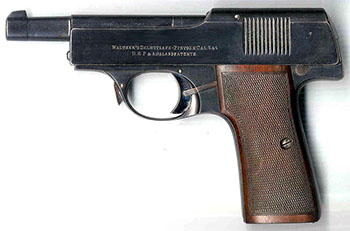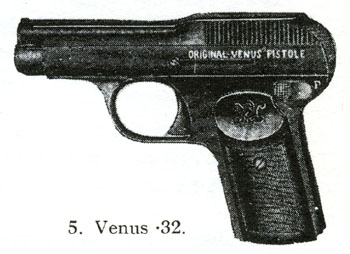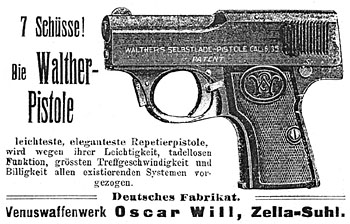 |
|||||||||||||||||||||||||||||||||||||||||||||||||||||||||||||||||||
|
An Experimental 7.65mm Walther Pistol by Ed Buffaloe
I had read about an early experimental Walther .32 somewhere, but when I went to look for the reference, I had difficulty finding it. First I looked in Dieter Marschall’s Walther Pistols, Models 1 - P99, then I looked in Manfred Kersten’s Walther: The German Legend, and finally I looked in Ian Hogg’s German Handguns, but none of these even mention an early .32. It turned out to be Gene Gangarosa, Jr.’s The Walther Handgun Story, where he says: “In 1908, experimentation was under way on two prototype Walther pistols. The first, called the Venus-Pistole, was a medium-frame .32 ACP (7.65mm Browning) caliber pistol, similar to both the FN Model 1900 and the Dreyse Model 1907. Walther’s Venus-Pistole never went beyond the prototype stage; but the other early experimental pistol...eventually became the Model 1.” Elsewhere Gangarosa explains that the early Walther manufacturing facility was called the Venuswaffenwerke, or literally “Venus Weapon Works,” hence the name “Venus Pistol.”
A
The Hogan Collection experimental pistol will inevitably be thought of by modern collectors as a .32 caliber Model 1. Both guns have a slide lock latch on the front of the trigger guard, an external connector bar on the left side that runs under the left grip, open-top slide, top-mounted external extractor, and a cross-bolt safety at the rear. Like the early version of the Model 1, there is no takedown button on the right side of the experimental pistol, as is found on the later version of the Model 1. Both guns have similar slide inscriptions, differing only in the caliber marking. The experimental pistol is marked on two lines in all capital serif letters: WALTHER’S SELBSTLADE-PISTOLE CAL 7,65 In this writer’s opinion, both the Hogan Collection experimental pistol and the Walther Model 1 bear a closer relationship to the 1900 Mannlicher pistol than to the 1900 FN Browning or the 1907 Dreyse referred to by Gangarosa. The Walther pistols, like the Mannlicher, have a fixed barrel with an open-top slide, top-mounted extractor, and the recoil spring located beneath the barrel, whereas the Browning and Dreyse both have side-mounted extractors; the Dreyse recoil spring surrounds the barrel, while the Browning’s is mounted above the barrel, and neither gun has a true slide. I am currently waiting for further photographs of the experimental Walther, but the lockwork of the Venus-Pistole will probably be similar if not identical to that of the Walther Model 1. There is no externally visible serial number on this gun, and I don’t know if it has an internal number or numbers.
Also on the right side is a Walther logo that looks a great deal like the Mauser powder barrel logo—in a round-cornered rectangle with the word “Walther” across it, squeezed smaller in the middle. I have never seen a Walther logo like this anywhere else.. |
|||||||||||||||||||||||||||||||||||||||||||||||||||||||||||||||||||
|
|||||||||||||||||||||||||||||||||||||||||||||||||||||||||||||||||||
|
Copyright 2013 by Ed Buffaloe. All rights reserved. |
|||||||||||||||||||||||||||||||||||||||||||||||||||||||||||||||||||
|
|
|||||||||||||||||||||||||||||||||||||||||||||||||||||||||||||||||||



